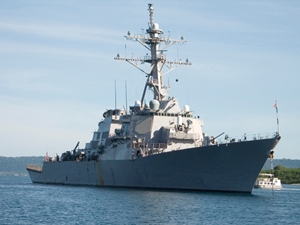This week marks the start of RIMPAC 2014, the multinational maritime training exercise. First started in 1971 by the U.S. Navy's Pacific Fleet, this program has joined naval units around the globe in a collaborative exercise for the past 23 years. The United States will be sending 24 ships to participate, including various cruiser, destroyer, frigate, aircraft carrier, amphibious assault, littoral combat, and attack submarine ships. Overall, the 2014 event will include 47 ships, six submarines, more than 200 aircraft carriers and 25,000 sailors.
Wide array of training exercises
RIMPAC will continue from this week until the beginning of August. The Pacific Fleet has scheduled events in the areas of disaster relief, maritime security operations, sea control and complex war fighting. The Navy has also planned a number of training exercises for participants of the event, including "amphibious operations, gunnery, missile, anti-submarine and air defense exercises as well as counterpiracy, mine clearance operations, explosive ordnance disposal and diving and salvage operations," according to the Navy.
New participants
For the first time, the People's Republic of China will be participating in the event, which aims to foster cooperative relationships between countries around the world to sustain better security on global ocean space. The event, held every two years, takes place in the Pacific Rim, in and around the Hawaiian islands. This ocean area in particular has a long history of naval action and warfare, as WWII veterans in life after service know. This year, 22 countries will participate in RIMPAC, including Australia, Brunei, Canada, Chile, Colombia, France, India, Indonesia, Japan, Malaysia, Mexico, Netherlands, New Zealand, Norway, the People's Republic of China, Peru, the Republic of Korea, the Republic of the Philippines, Singapore, Tonga, the U.K., and the U.S. Both China and Brunei are first-time participants.
The U.S. Navy invited China to the event in the hopes of easing growing naval tensions between that country and neighboring states. As China's naval forces have grown, a few territorial disputes have occurred with Taiwanese and Vietnamese naval forces.
"As the United States builds a stronger foundation for a military-to-military relationship with China, it also will continue to monitor China's evolving military strategy, doctrine, and force development and encourage China to be more transparent about its military modernization program," read the Pentagon's annual 2014 report to Congress.
Global maritime cooperation
Hopefully, the invitation and acceptance to participate in this years RIMPAC exercise will improve the relationship between China's navy and U.S. defense, answering part of the question of, as Ronald O'Rourke explained in a Congressional Research Service report, "how the U.S. should respond to China's military modernization effort, including its naval modernization effort," which he cites has having "emerged as a key issue in U.S. defense planning."
In a meeting between President Barack Obama and Chinese President Xi Jinping, they agreed that "enhanced and substantive military dialogue and communication would foster greater understanding and expand mutual trust."

